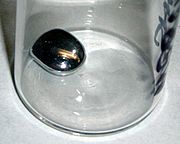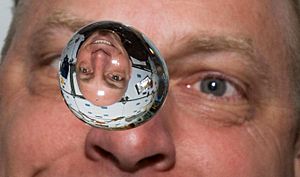Cohesion (chemistry) facts for kids
Cohesion is a cool science word that means "sticking together." It describes how molecules of the same substance are attracted to each other. Think of it like a group of friends who always want to stay close!
This sticking-together happens because of the unique shape and structure of molecules. When molecules get close, their tiny electrical charges can create a pull, making them cling to one another. This pull is strong enough to create things like a water drop or even let a tiny insect walk on water!
In simple terms, cohesion helps create what we call surface tension. This makes the surface of a liquid act a bit like a thin, stretchy skin.

For example, water is super cohesive. Each water molecule can form four special connections, called hydrogen bonds, with other water molecules. These bonds are like invisible tiny magnets, making water molecules really stick together. This is why water forms round drops and doesn't just spread out everywhere.
Cohesion works hand-in-hand with adhesion, which is when different kinds of molecules stick together. Together, these forces help explain many interesting things we see every day, like how water climbs up a thin tube (called capillary action), how drops form, and why liquids have a curved surface in a glass (a meniscus).
Contents
How Molecules Stick Together
Cohesion is all about the tiny forces between molecules. Imagine each molecule has a slightly positive and a slightly negative side. When these sides get close to the opposite side of another molecule, they pull towards each other. This pull is called an intermolecular force.
Water's Special Stickiness
Water molecules are shaped a bit like Mickey Mouse heads, with two "ears" (hydrogen atoms) and one "face" (oxygen atom). The oxygen side has a slight negative charge, and the hydrogen sides have slight positive charges. This makes water molecules very good at forming hydrogen bonds, which are strong attractions between the positive part of one water molecule and the negative part of another.
Why Water Forms Drops
Because water molecules are so attracted to each other, they try to pull inward, creating the smallest possible surface area. This is why water forms round drops instead of spreading out flat, unless something else (like a very clean surface) pulls on them more strongly.
Mercury: A Different Kind of Stickiness
Mercury, the shiny liquid metal, is also very cohesive. However, its molecules are even more attracted to each other than water molecules are. This is why mercury forms very round, bead-like drops and doesn't easily stick to surfaces like glass. It prefers to stick to itself!
Cohesion in Everyday Life
You can see cohesion in action all around you!
- Raindrops: Raindrops are round because water molecules pull together.
- Dew drops: Tiny beads of water on grass in the morning are formed by cohesion.
- Walking on water: Some insects, like water striders, can walk on the surface of a pond because of water's strong surface tension, which is caused by cohesion.
- Cleaning: Cohesion helps water cling to dirt particles, making it easier to wash things away.
Images for kids
See also
 In Spanish: Fuerzas de cohesión para niños
In Spanish: Fuerzas de cohesión para niños



